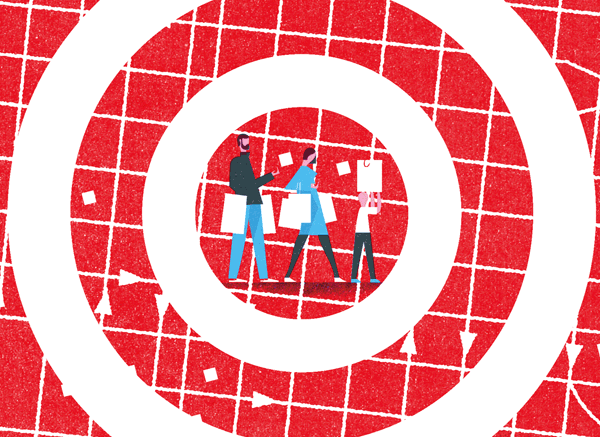Why Target Is Coming to Downtown Portland

Image: Matthew Hollister
On October 1, 1976, Portlanders jammed the streets around SW 10th Avenue and Morrison Street to celebrate the $6.5 million renovation of the empty Olds & King department store. Mayor Neil Goldschmidt cut the ribbon at the rechristened “Galleria,” signaling the project’s importance in a larger effort to save Portland’s urban core.
Downtown had lost its mojo. The Galleria was supposed to get the city’s heart thumping again, emphasizing “small shops and charm” to battle the big malls—Lloyd Center opened in 1960, Washington Square in ’74—that lured shoppers away.
Later this month, history replays, but in reverse. The Galleria, for a long time itself moribund, will welcome CityTarget, an 89,000-square-foot outpost of the Minneapolis-based store that mixes name-brand designers into the old formula of everything under one roof. Shoppers will throng again, in pursuit of Kate Young dresses, Prabal Gurug pointy-toed pumps, and cheap toothpaste.
This time, however, the subtext is not the city center’s desperation, but its desirability. To paraphrase a 1976 Galleria ad, major brands have decided that “now it’s a lot more fun to come to downtown!”
After decades in which suburbs and exurbs drove retail, people now want to spend money in the city. In Portland, H&M, Nike, Sephora, and Microsoft have already staked out downtown showpieces. Apple plans a blocklong, 23,000-square-foot megastore. City planners hint other big names will follow soon.
Portland leaders hustled to land Target. (Former mayor Sam Adams once described practically stalking company execs.) But analysts say the new store represents powerful national forces. “The suburbs are overretailed,” says Robert Gibbs, a Michigan-based consultant. “Most city centers have about one to two square feet of retail per person. The suburbs have as many as 50.” That means some of America’s most intensely trafficked neighborhoods are mass-retail deserts.
The economic crack-up of 2008–09 transformed spending habits. According to the National Retail Federation, shoppers are buying less and flocking to “value.” Nationally, center-city workers are doing more shopping during work hours. The 82 million “millennials” (ages 18–29), who already outspend baby boomers, gravitate both to urban living (driving is way down among that generation) and bargains.
“Millennials tell you they prefer independent stores,” says Kennedy Smith, a national expert on downtown retail and revitalization. “But where did they buy their last T-shirt? Target.”
In fact, Target has largely abandoned expanding in suburbs in favor of center cities. The company debuted its “CityTarget” model—30,000 to 40,000 square feet smaller than its suburban stores—last July, building stores in LA, Seattle, Chicago, San Francisco, and elsewhere. Other national brands are watching closely. (“Retailers are followers, not leaders,” Smith says.) Target itself says it’s assessing the strategy before plunging deeper.
That puts all eyes on the Portland store, which sits in what looks like prime territory for this new retail reality.
“In the past two decades, Portland’s downtown has been ahead of the rest of the country,” Gibbs says. Some momentum dates back to Goldschmidt, who carved out short-term parking, required ground-floor commercial space, and locked in a walkable, transit-threaded grid of high-density retail. Other factors are more recent. Portland’s downtown population has grown by 21 percent over the past decade (compared to 10 percent citywide growth).
Since 2009, the Portland Business Alliance and Portland Development Commission have courted a wish list straight out of the burbs: French Connection, JCPenney, Cheesecake Factory. Meanwhile, local shops multiply, with the likes of Boy’s Fort, Poler Stuff, and the forthcoming Union Way shopping alley now shoulder to shoulder with the big boys. Stats from Portland State University’s Center for Real Estate suggest that the central city is Portland’s most thriving retail environment. The PSU center predicts the retail vacancy rate downtown will drop over the next year (it’s hovered steadily at around 5.9 percent) while rents continue a slow upward climb (currently averaging $15.83 per square foot).
How much would be too much for those indie shops? So far, proprietors seem relaxed. “Anytime a chain comes in, rents go up,” says Sean Igo, co-owner of the boutique Canoe, two blocks away from the forthcoming CityTarget. “But I’m not really worried.”
In Portland, big brands do face a fundamental problem: space. Many more big arrivals to our pint-size blocks would require construction—or departures. Fast-fashion mecca H&M arrived only after Saks Fifth Avenue left in 2010. Microsoft snagged the old Macaroni Grill. And Apple is demoing another Saks locale. Still, if Target’s “small-box” model succeeds, retailers may decide they don’t need wide-open spaces. Is that a Walmart greeter we hear? (Oh, relax. There’s no talk of that. Yet.)
What came before Nordie’s, Pioneer Place, and Target? Watch downtown Portland’s shopping scene evolve in our historic slide show




